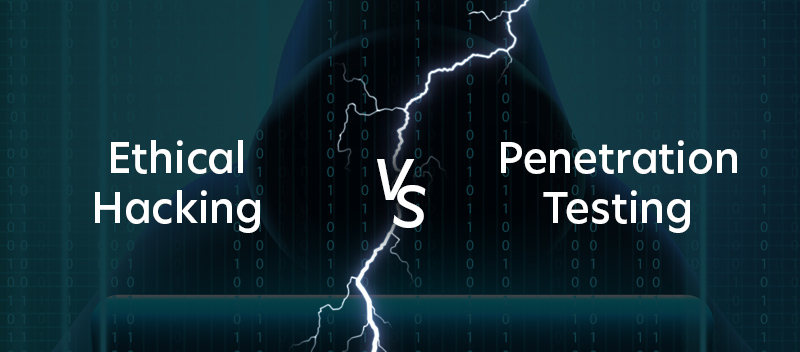Ethical Hacking vs. Penetration Testing: A Comprehensive Guide

Penetration testing is gaining so much traction that it is estimated that by 2025, it will be a $4.5 billion industry (Gartner). But what about ethical hacking? Do these two approaches represent distinct settings in the cybersecurity environment, or are they just different names for the same idea?
Let’s examine this more to see if there are any differences between them.
Ethical Hacking vs. Penetration Testing: Key Differences
Understanding the roles of ethical hackers and penetration testers is essential. Both are pivotal in defending digital landscapes, yet their functions and approaches hold distinct differences that are important to grasp.
1. Ethical Hacking
Ethical hacking is a proactive approach that encompasses a wide array of techniques aimed at securing IT environments. As an ethical hacker, you perform tasks like:
- Web application hacking to secure online platforms.
- System hacking to ensure your internal networks are robust.
- Web server hacking to protect against unauthorized access.
- Wireless network hacking for safeguarding Wi-Fi connections.
- Social engineering tests to prevent manipulation of individuals within your organization.
The ultimate goal here is to preemptively identify vulnerabilities before malicious hackers can exploit them, using a holistic approach to enhance overall security.
2. Penetration Testing
On the other hand, penetration testing is more targeted and structured. It involves a coordinated assessment where an independent team is brought in to simulate cyberattacks on specific systems. This is done with the scope and boundaries clearly defined by you, the client. Here’s how it works:
- Scope Definition: You decide which systems to test and the methods allowed.
- Execution: The penetration tester simulates attacks based on your criteria.
- Exploitation: Any vulnerabilities found are exploited to understand the potential risks, providing you with a detailed analysis of the system’s weaknesses.
Similarities
Despite their differences, ethical hacking and penetration testing share common ground. Both roles are dedicated to:
- Identifying vulnerabilities in IT systems.
- Helping you prevent a wide array of cyberattacks.
- Strengthening your cybersecurity posture through thorough analysis.
By understanding these nuances, you can better leverage these practices to protect your digital assets effectively.
Learn more about our Penetration Testing services Here
Ethical Hacking: A Deeper Dive
Ethical hackers play a crucial role in keeping your systems safe from malicious threats. Let’s explore how they operate to protect your digital assets.
– Authorized Access
Ethical hackers are granted permission to access systems and networks, setting them apart from their malicious counterparts. With authorized access, they can delve into your digital infrastructure without legal repercussions, ensuring that their activities are both compliant and beneficial to your organization.
– Simulate Attacks
One of the most fascinating aspects of ethical hacking is the ability to simulate real-world cyberattacks. By mimicking the strategies used by cybercriminals, ethical hackers can test your defenses and understand how your systems would hold up under pressure. These simulations include:
- Reconnaissance: Gathering intelligence on your systems, much like an adversary would.
- Gaining Access: Exploiting potential vulnerabilities to see how far they can penetrate.
- Maintaining Access and Clearing Tracks: Ensuring they can sustain a presence and then erase evidence of their testing, all while within legal bounds.
- Identify Vulnerabilities: At the heart of ethical hacking is vulnerability identification.
Ethical hackers employ a combination of technical skills and creative thinking to uncover weaknesses that could be exploited by real attackers. This might involve:
- Scanning and Testing: Using tools to find and analyze security gaps.
- Reporting: Documenting findings with recommendations to bolster your defenses.
By identifying and addressing these vulnerabilities, ethical hackers help ensure that your systems are resilient against evolving cyber threats.
Penetration Testing: A Closer Look
Diving into penetration testing can seem daunting, but with a clear understanding of the process, you can see how it fortifies your cybersecurity defenses. Let’s break it down step-by-step.
1. Scope
Before any testing starts, it’s essential to establish clear boundaries. This is where scoping comes into play. Together, we draft a pre-engagement contract that acts as our roadmap. This document outlines the rules of engagement, priorities, timeframes, and methods for the test. It ensures everyone is aligned and provides legal protection, establishing a safe environment for the testers to operate within your systems.
2. Methodology
Penetration testing methodologies vary based on the perspective and depth you require:
- Black Box Testing: This method utilizes an external hacker who has no prior knowledge of your system. This method tests your defenses from an outsider’s view, highlighting vulnerabilities that could be exploited by real-world threats.
- White Box Testing: Now, think of an insider with full access to your system’s intricacies. This approach allows for a thorough examination, uncovering vulnerabilities that might not be visible from the outside.
- Gray Box Testing: This is a blend of both worlds. It provides partial knowledge of the system, focusing on specific areas that could be susceptible, giving a balanced view of your security posture.
3. Testing Phases
The penetration testing journey is structured into several key phases:
- Reconnaissance: This detective work involves gathering as much information about your systems as possible. It’s about understanding the landscape before diving in.
- Penetration Attempt: Here’s where the action happens. Testers actively try to exploit vulnerabilities, simulating how far an attacker could go, whether it’s accessing confidential data or altering system configurations.
- Reporting: After the tests, a detailed report is crafted. This document outlines the vulnerabilities discovered, the methods used, and actionable recommendations to strengthen your defenses.
- Re-Testing: Implementing changes is just the beginning. Regular re-testing is crucial to ensure that fixes are effective, and your systems remain resilient, especially after infrastructure changes.
By understanding these aspects, you can better navigate the penetration testing landscape, ensuring your systems are fortified against potential threats.
Penetration Testing as a Service (PTaaS)
Penetration Testing as a Service (PTaaS) has emerged as a robust solution to enhance your security posture. Let’s explore how PTaaS works and what benefits it can bring to your organization.
Penetration Testing as a Service (PTaaS) Definition
PTaaS combines automated techniques with expert analysis to uncover vulnerabilities that traditional scanning tools might miss. By offering both point-in-time and continuous testing options, PTaaS helps you build a comprehensive vulnerability management program.
PTaaS operates remotely, using a three-step approach: baseline assessment, regular evaluations, and continuous retesting. This efficient method leverages automation and machine learning, eliminating the need for manual setup and configuration and enhancing both speed and accuracy.
Benefits of Penetration Testing as a Service (PTaaS)
Embracing PTaaS presents several advantages:
- Flexibility: PTaaS vendors offer various packages and pricing models, allowing you to choose a plan that fits your budget and needs.
- Real-Time Data: With continuous access to up-to-date information, you can swiftly address security vulnerabilities as they arise.
- Comprehensive Reporting: PTaaS provides flexible reporting options, catering to both high-level executive summaries and detailed technical insights, ensuring that all findings are communicated effectively.
Key Considerations
When selecting a PTaaS provider, keep these factors in mind:
- Vendor Reputation: Look for a provider with a solid track record and positive feedback from other clients.
- Integrated Features: Ensure the service can aggregate and correlate data from multiple sources, with capabilities like simultaneous testing by multiple testers and generating reports in various formats.
- Compatibility: Check if the reporting integrates smoothly with your enterprise systems, such as ticketing and governance, risk, and compliance (GRC) platforms.
By carefully evaluating PTaaS providers, you can select a service that not only strengthens your cybersecurity defenses but also aligns seamlessly with your organizational goals.
Choosing the Right Approach: Ethical Hacking vs. Penetration Testing
Selecting the appropriate cybersecurity strategy for your organization can feel overwhelming, but by considering a few key factors, you can make an informed decision that best suits your needs.
— Assessment of Needs
To determine whether ethical hacking or penetration testing is the more suitable option, start by evaluating your organization’s specific vulnerabilities and security goals. Ask yourself:
- Do you need a broad evaluation of your entire security framework, which ethical hacking can provide through various techniques and tests?
- Or do you require a focused examination of specific systems or applications that penetration testing can deliver within its defined scope?
Ethical hacking is ideal for organizations seeking a comprehensive security review, while penetration testing is perfect for targeted assessments.
— Budget and Resources
Your budget and available resources will significantly influence your choice. Consider:
- Ethical hacking often involves ongoing processes and may require a higher initial investment but offers extensive security insights.
- Penetration testing, with its defined scope, can be more cost-effective for specific projects or periodic assessments.
Balancing your financial capacity with your security needs will guide you in choosing the approach that aligns with your organizational priorities.
— Regulatory Requirements
Compliance with industry regulations and standards can also steer your decision. It’s important to ask:
- Are there specific regulatory requirements mandating regular penetration tests or comprehensive security evaluations?
- How can each approach help you meet these compliance obligations effectively?
Understanding the regulatory landscape ensures that your choice not only fortifies your security but also keeps your organization compliant with necessary guidelines.
Unlock Robust Cybersecurity with TrustNet’s Expert Solutions
In this guide, we’ve explored the essential differences between ethical hacking and penetration testing, the benefits of PTaaS, and how to select the right approach for your security needs. Each of these strategies plays a vital role in fortifying your defenses and ensuring regulatory compliance.
At TrustNet, we specialize in providing tailored security solutions, including external and internal penetration testing, cloud security assessments, and social engineering evaluations. Our comprehensive services are designed to address your unique challenges and protect your critical assets.
Enhance your organization’s defenses with TrustNet’s expert penetration testing services. Contact us today to request a free penetration testing quote.




